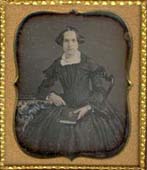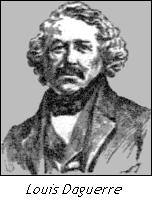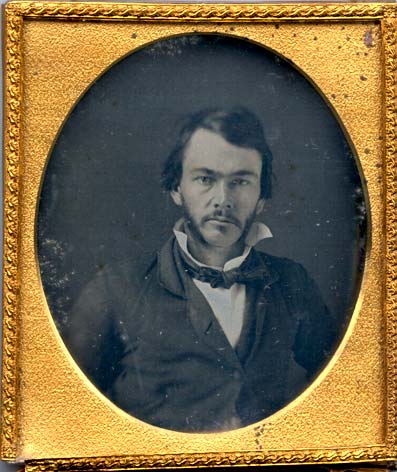







 |
Jump to
the Dag's gallery at the bottom of the page
 Being
confronted with the challenge to use his Camera Obscura to help to the
drawing of a scenery for his Parisian theatre gives Daguerre the idea to
consider the work of Joseph-Nicephore Niépce. Very quickly, the two men
decide to collaborate. When he dies in 1833, Niépce leaves an unfinished
work. Daguerre, who has shared Niépce's researches, decides to pursue the
work of his colleague in order to improve the process of fixing a picture
on a metal plate. His objective is to implement a more reliable process,
less complex but above all, faster than the one invented by Niépce. Being
confronted with the challenge to use his Camera Obscura to help to the
drawing of a scenery for his Parisian theatre gives Daguerre the idea to
consider the work of Joseph-Nicephore Niépce. Very quickly, the two men
decide to collaborate. When he dies in 1833, Niépce leaves an unfinished
work. Daguerre, who has shared Niépce's researches, decides to pursue the
work of his colleague in order to improve the process of fixing a picture
on a metal plate. His objective is to implement a more reliable process,
less complex but above all, faster than the one invented by Niépce.
This is done in 1837, and Daguerre decides to give his name to his invention:
the "Daguerreotype."
Daguerreotypes are sharply-defined, highly reflective,
one-of-a-kind photographs on silver-coated copper plates, packaged behind
glass and kept in protective cases. They appear to have a mirror-like
finish that has to be turned first this way and then that in order to view
the image on the plate surface. Daguerreotypes were displayed usually
 with a solid-brass mat that rested directly on the surface of the
daguerreotype. On top of the mat was placed a clear piece of glass the
same size as the daguerreotype image. Glass, mat, and dag were then held
together around the perimeter by what is known as a "preserver" made of
lightweight embossed brass that folded over the back side of the
daguerreotype. This "package" was then inserted into a small
leather-covered wooden case with a cover that hooked shut over the image
to block out damaging rays of light. with a solid-brass mat that rested directly on the surface of the
daguerreotype. On top of the mat was placed a clear piece of glass the
same size as the daguerreotype image. Glass, mat, and dag were then held
together around the perimeter by what is known as a "preserver" made of
lightweight embossed brass that folded over the back side of the
daguerreotype. This "package" was then inserted into a small
leather-covered wooden case with a cover that hooked shut over the image
to block out damaging rays of light.
The daguerreotype process was the
first commercially successful photographic process, and is distinguished
by a remarkable clarity of pictorial detail. Although early
daguerreotypes required exposures of several minutes, advances in the
process quickly reduced exposure times. Daguerreotypes were popular
through the 1840s and into the 1860s, especially for portrait photography;
they were primarily replaced by less-expensive and more easily viewed
ambrotypes and
tintypes, as well as by the improved
negative-positive techniques of collodion on
glass negatives and albumen prints.
A century
later, only days before the start of the Second World War, the most
incredible collection of French daguerreotypes was bought by the Eastman
Kodak Company and exported to the United States without raising any outcry
from French art representatives. What still remains in France today of
these pieces of its great national heritage in photography? Unfortunately
very few things...
Hereunder, some of these great
pictures.
United States, c.1850 - 1/6 plate United States, c.1850 - 1/9 plate United States, c.1855 - 1/6 plate United States, c.1855 - 1/9 plate United States, c.1850 - 1/4 plate United States, c.1855 - 1/9 plate United States, c.1855, 1/6 plate United States, c.1850, 1/6 plate United States, c.1850 - octagonale 1/6 plate
United States, c.1853~1857, 1/4 plate United States, 1864, oval plate United States, c.1855, 1/9 plate United States, c.1861, ovale plate United States, c.1861, oval plate France, c.1850 - 1/6 plate
United States, c.1850, 1/6 plate United States, c.1850, 1/4 plate United States, c.1855, rare 1/9 plate United States, c.1855, 1/4 plate United States, C.1855, rare 1/9 plate United States, C.1855, rare 1/9 plate United States, C.1850, rare 1/9 plate United States, 1848~1852, 1/6 plate United States, 1850, Bethlehem United States, c.1860, 1/16 plate United States, c.1850, 1/6 plate United States, c.1850, 1/6 plate United States, c.1855, 1/6 plate United States, c.1850, 1/2 plate United States, c.1850, 1/6 plate United States, c.1850, 1/4 plate United States, c.1850, 1/6 plate United States, c.1848, 1/6 plate
Exceptionnal daguerreotype on a resilvered plate.
The wife is in control... Remarkable tinted portrait of a young woman showing her winter cape lining. Dad and his young Daugther Portrait of a father and his little daughter. This one is wearing a large medallion and two small coral bracelets which have been delicately tinted by the daguerreotypist.
Daguerreotype on a resilvered plate. Family's portrait
Mother, Father and Daugther Exceptional husband & wife pair of dags. In addition of an unbelievable range of richness of tones, the other particularity of these dags is to be vignetted (the two images appear in an oval). Tinted portrait of an american business man, made by the famous daguerreotypist Jeremiah Gurney. The address of his studio is imprinted on the plate: 529 South Broadway, New York. Portrait dated of 1864 of Ozayier Lemoul-Whitney, born in July 24th, 1862 in New-York city.
Daguerreotype on a resilvered plate. Portrait of the young Mr. H.H. Sheldon Portrait of Mr. H.H. Sheldon Portrait of Mrs Sheldon, wife of Mr. H.H. Sheldon. Portrait of a man, done by Jules Malacrida.
In 1851, together with another photographer (Félix-Jacques-Antoine Moulin, 1802-1875), Malacrida was condemned for producing academes (stereo nude studies). During the lawsuit, the judge presented these pictures as "...so obscene that just telling their titles would be an outrage to public decency".
No, this is not a portrait of the famous french actor Jean Gabin but the one of his double, born almost a century before...
Daguerreotype on a resilvered plate. Daguerreotype representing Wn F. Westerfield, born on february 25th, 1832. The last gift from Dorisa to Jessie. "This picture falls to Jessie when I am gone. Dorisa".
Portrait of a rich californian. Young couple.
Daguerreotype on a resilvered plate. Very unusual portrait of a couple from the mid XIX century. This picture tells us a lot about the passion who certainly existed between this man and this woman. Tinted daguerreotype on a resilvered plate.
Part of a set of 3 dags which came all together from the same origin. Tinted daguerreotype of Elizah Hammond
Part of a set of 3 dags which came all together from the same origin.
Part of a set of 3 dags which came all together from the same origin.
Portrait of a man wearing a high hat.
The plate has a very peculiar yellow varnish is its the copper side. According to Dennis Waters, this was the hallmark of plates made only by the famous daguerreotypiste Matthew Brady in his studio located at 205-207 Broadway, New-York. Daguerreotype on a resilvered plate made by an unknown operator in Bethlehem, Pennsylvania. Small daguerreotype of a homely woman. This close-up portrait indicates a late daguerreotype, probably after 1860. Portrait of an Average Joe. Daguerreotype on a resilvered plate. "Sinister man". Daguerreotype on a resilvered plate. Daguerreotype on a resilvered plate. Superb portrait of a young couple.
Portrait of rich looking gent. His dress coat with wide sleeves indicates he was possibly a physician or a surgeon. Tinted daguerreotype on a resilvered plate.
Portrait of a couple on a resilvered plate. The veins on the husband's and wife's hands are clearly in view. Portrait of tow young americans (brothers maybe) made with a resilvered plate manufactured in France and marked "40 GARANTIE".
This dag was probably one of the early ones made in United Stated using the process discovered by Daguerre. Daguerreotype of Georges Jackson.

United States, c.1850 - 1/6 plate
Exceptionnal daguerreotype on a resilvered plate.
| |
 Nombre
de visiteurs Nombre
de visiteurs
Number of visitors |
|


